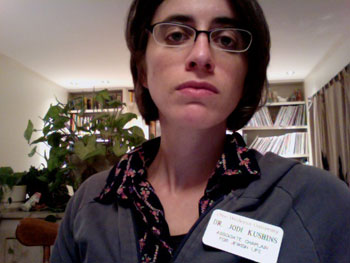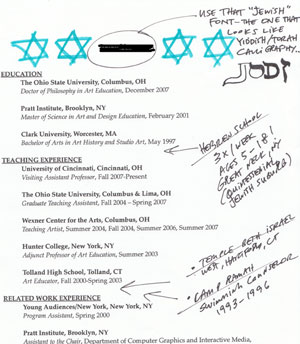I’m Not Really a Chaplain; I Just Play One to Pay the Bills
Jodi Kushins
"I'm Not Really a Chaplain; I Just Play One to Pay The Bills" is a reflection on the workplace rhetoric I have engaged in transforming myself from a professor at a large research university to a religious life leader on a small liberal arts college campus. Writing this piece allowed me time and space to contemplate what this change has provided and demanded of me personally, professionally, and spiritually.
At many times in my life, I’ve felt like an actor. You know that feeling? The one where you kind of step outside yourself for a moment and see your life as if it’s a movie? The one where you can’t believe or understand how you came to be doing whatever it is that you’re doing?
Spending your first night alone in a new apartment in a city where you don’t know anyone, for example. Waking up before the sun to take your step-kids to school, in a minivan registered in your name. Or hearing people refer to you as Chaplain at a small midwestern liberal arts college shortly after finishing a Ph.D. in a completely unrelated and secular field. But somehow, it’s not a movie. It’s your life; or in this case, mine.

"If the label fits"
Last year, I applied for a part-time position as Chaplain for Jewish Life at a Methodist-chartered college. My teaching contract as Visiting Professor of Art Education at another university was about to expire, I didn’t want to reapply, and there weren’t any other jobs available in my field that met my geographic requirements. So, before I had a chance to wake up the star of a movie in which I played an out-of-work academic, I began the process of reinventing myself.

"My resume, revisited"
I revised my C.V. to highlight my personal Jewish history. I added time I spent teaching second graders Hebrew language and Torah stories to my list of teaching experiences. I highlighted my work at a prominent Jewish summer camp. And I added my affiliation with a lay-led Jewish congregation to my list of organizational memberships. In my letter of interest and during interviews, I likened my own search for a Jewish identity in the Midwest to the search students at the college might be experiencing as they make a life for themselves outside their parents’ homes, at a college founded by Christians. For the first time in years, I unfurled my Jew flag and let it fly.
In an attempt to package myself as an intellectual, hip, young Jew prepared to take on a new role as lay leader, I was drawing on my previous experiences and setting a course of future action. This was both a creative branding exercise and a profound opportunity for me to consider how this position might enable me to make time and space for Judaism at this stage of my life.
Raised in a tight-knit Conservative Jewish community on the East Coast, I learned how to be a good Jew. I went to Hebrew school three times a week through my senior year of high school, went to temple every Saturday for Shabbat and on all the holidays (if you don’t know how intense a commitment that is, check out this calendar), and I kept kosher. By the time I left for college, I was ready for a break from all the rules and demands.
Later in life, I was introduced to Reconstructionist Judaism, which offered my first taste of how to do Judaism differently, in what felt like more authentic relation to other parts of my life. I often describe Reconstructionism as D.I.Y. Judaism, for while there are Reconstructionist Rabbis, there are also groups in this denomination who run our own services and religious education programs.
This modern movement views Judaism as an evolution of ideas and actions—an ever-changing series of interpretations, rather than the performance of static traditions. The goal is personal, communal interpretation of Jewish laws and customs rather than adherence to a single leader’s mandate. For example, while the Conservative movement I grew up within dictates that only a sofer (a trained scribe) can write the parchment for a mezuzah (the sacred door marker found on most Jewish homes and businesses), Reconstructionism might ask, “What meaning would it bring to the mezuzah if we took on this act of writing for ourselves?” This aspect of Reconstructionism appeals to my skepticism about religious authority. I believe its teachings on critical thinking, conscious spiritual practice, and community building can have relevance for college students, particularly in a liberal arts context.
In addition to Reconstructionism, I wondered whether an edgy brand of Judaism that I began to notice a few years ago and which resonated with my own creative spirit might do the same for my students. Were they aware of the steady stream of publications like Heeb: The New Jew Review, the Chassidic Reggae/Hip Hop artist Matisyahu, or Jewish/pop culture screen printed t-shirts coming out of New York and Los Angeles? Such artifacts of 21st century Judaism make use of irony, empowerment, and the Internet to captivate an audience of young, often disinterested Jews. Could I harness that energy to provide intellectually and Judaically stimulating programming that would appeal to students with a wide range of Jewish backgrounds and commitments?
Before I could figure out how to reach my constituents, I had to consider who they are. Indeed, the students I work with are in a similar position to mine at their age. They chose to attend a school where Jews make up a small minority of the student body, rather than schools on the East Coast or large state schools like Michigan State University or The Ohio State University. Many don’t feel compelled to attend Jewish programming on campus. I can understand where they are coming from since I didn’t participate in any formal Jewish activities in college.

"Friday night Shabbat service"
(Courtesy of Mark Schmitter of OWU’s Transcript)
In response, I try to find creative ways to reach students whose attention is not only being drawn in multiple directions by 21st century technologies but who have little interest in Judaism because they identify it with boring prayers and old-fashioned rules. For example, our Friday night Shabbat services include readings that connect the Jewish Day of Rest to contemporary calls for unplugging from the stream of communication technologies to reconnect with our fellow flesh-and-blood human beings. Recently I introduced meditation cushions to the set-up of the room to add an element of physical change.

OWU mascot
For Purim, the holiday that celebrates women leaders through the story of Queen Esther, we held a bake sale called “Hamantaschen for Haiti” which combined students’ love of all things sweet and tasty (hamantaschen are tri-cornered fruit-filled cookies eaten for this holiday) with their concerns for the recovery efforts in Haiti. Alongside the sale, we performed a Purim schpiel (skit) that retold the story of Esther with pop culture and academic references including Esther declaring, “well-behaved women rarely make history,” and the King offering his Queen anything she wants: “You can have my Wii, my Prius, and all the bling you dare cast your eyes upon.”

"OWUJew"
On an everyday level, I wanted to figure out how to express and explore Jewish identity for my constituents. Ohio Wesleyan’s mascot is a character known as the Battling Bishop. (Remember, we’re a Methodist-charted institution.) I found it nearly impossible not to imagine the Bishop dressed up as a Rabbi. And the word Jew rhymes so easily with the nickname students, faculty, and staff use to refer to the school OWU (pronounced oh woo). And so, OWUJew was born.
In addition to redesigning the school logo to be reprinted on t-shirts, magnets, and buttons, I started a blog, OWUJew, where I post commentary on a range of subjects that I hope will be of interest to my students. The blog has provided me the freedom to explore my voice as a Jewish leader and to engage in the kind of conceptual writing that I enjoy as an academic. In that writing, I often find myself struggling to balance my own critical thinking and creative expression with my responsibilities to uphold the reputation of the university with which I’m affiliated and the trust of more conservative Jewish students on campus. It’s an exciting intellectual challenge.

Author as Queen Vashti (in “Exile from Shushan”)
I still find my title, Associate Chaplain for Jewish Life a bit hard to believe. I have no formal training as a religious leader and yet, I have the business cards and badges that identify me as such. In the end, it’s not so much that I’m not a chaplain, but that I don’t feel like the Jewish leaders I grew up with. Overcoming my own perceptions of how I think I’m supposed to look and behave has, thus far, been one of my greatest achievements in this position.
Jodi Kushins is Associate Chaplain for Jewish Life at Ohio Wesleyan University. She holds a Ph.D. in Art Education which she uses in other part-time jobs and to advocate community art projects in Columbus, OH.